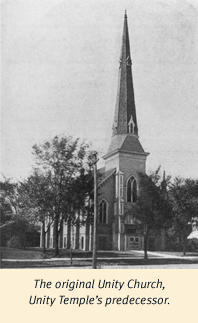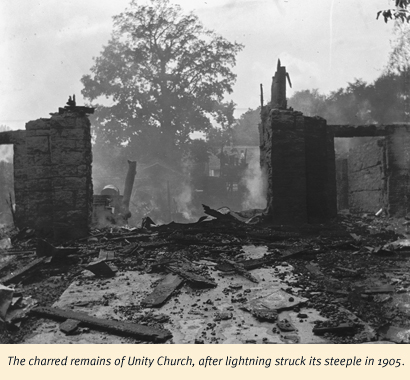AT ABOUT 5:00 A.M. on the morning of June 4, 1905, a violent thunderstorm hit the village of Oak Park, Illinois, and one of the many bolts of lightning that dramatically lit up the sky hit the steeple of the Unity Church. The steeple soon came crashing down, and the entire wooden structure fell to the flames; within a short time, it was completely destroyed. From the ashes of this local tragedy was to spring one of the great architectural achievements of the early twentieth century. 
Unity Church, the predecessor of Oak Park's Unity Temple, had been founded on January 25, 1871, when eleven Unitarian and Universalist-oriented members of the Union Church met in the home of E.W. Hoard to discuss the formation of a new and liberal organization. There were already several congregations and at least one freestanding Sunday school in the area comprising both present-day Oak Park and the Austin area of Chicago to the east, and many people were loosely affiliated with and supported more than one of the struggling religious institutions. This was especially true of the business and civic leaders in the adjacent communities of Oak Park and Ridgeland (now joined together as Oak Park), as they thought it important to have strong and viable institutions to attract settlers who would buy their land and purchase from the businesses they controlled. Though the Union Church leaned toward the most liberal form of Protestant worship and governance, the group who held this organizational meeting had become increasingly uncomfortable with the direction being taken by their eight-year-old congregation, as it moved from an evangelical but non-denominational institution toward a closer identification with the established Congregational denomina- tion of Protestantism. And, when it appeared that Union Church might actually affiliate with the Congregationalists, those committed to a more liberal form of belief felt it was time to act. At that first organizational meeting, an amount in excess of $5,000 was pledged toward the construction of a church, and within a week the fledgling congregation had adopted both a constitution and by-laws, and taken the name Unity Church of Oak Park. The first board of trustees was elected at a special meeting on March 1, with Edwin O. Gale, an astute and successful businessman, as treasurer, and with the selection of a five-member building committee. 
One of the members of the committee was Milton C. Niles, a large landowner who played a pivotal role in the location and funding of the new church building. It was decided to build the church near the southwest corner of Wisconsin Avenue (now Marion) and Pleasant Streets, close to the Harlem stop on the railroad. The group agreed to purchase a lot from Niles: he then donated the adjacent piece of property to the church, a fact that must have influenced the decision in favor of that location at least as much as the proximity to the railroad station, for there was a lot of open land in the area. Construction began almost immediately, a minister was hired, and the church was completed in just over a year and dedicated on August 11, 1872. The church was a traditional Gothic Revival structure of one floor, with neither side-aisles nor a crossing, but with a tall steeple at the entrance end and with engaged buttresses between each bay. The name of the architect is lost, but it is known that the total cost of land and construction came to $13,869 with $5,600 of the total donated by the treasurer Gale. |

Top Five Books, LLC,
is a Chicago-based independent publisher dedicated to publishing only the finest fiction, timeless classics, and select nonfiction.
is a Chicago-based independent publisher dedicated to publishing only the finest fiction, timeless classics, and select nonfiction.
© Top Five Books, LLC. All rights reserved.